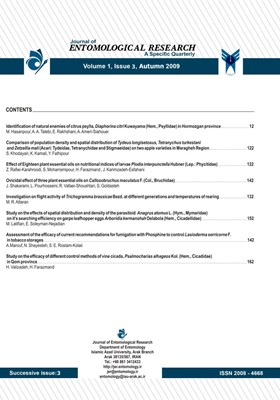Assessment of the efficacy of current recommendations for fumigation with Phosphine to control Lasioderma serricorne F. (Col., Anobiidae) in tobacco storages
Subject Areas : entomology and othea arthropodsA. Marouf 1 , N. Shayesteh 2 , S. E. Rostam-Kolaii 3
1 - Iranian Research Institute of Plant Protection, Tehran, Iran
2 - Plant Protection Department, Agricultural faculty, Urmia University, Urmia, Iran
3 - Tirtash Tobacco Research Institute, Behshahr, Iran
Keywords:
Abstract :
Lasioderma serricorne (Fabricius) is one of the damaging agents in all producing stages of tobacco, from processing to cigarette, in almost all over the world. To control this pest in Iran every year costly fumigation programs are carried out which sometimes cause hygienic problems for fumigation workers too. In this study four tobacco storages in Sari, Bandar-e-Torkman (2 stores), and Gorgan (totally 15575 m3) were fumigated with current recommended phosphine fumigation doses. That is, one 3-gram Phostoxin® tablet (Degesch; Germany) was used to fumigate every m3 of bales and tobacco boxes. For this purpose tablets were put in metal trays over the boxes covered by gas-proof plastic sheet for 96 hours. To investigate the efficiency of fumigation, pheromone traps were employed. Traps were examined from late June through early November every week and the numbers of collected insects were recorded. The results of the study revealed insect control failure in all the storages and insects had been trapped from the second week after phosphine treatment. The reason might be deficiency of current recommendations for fumigations or occurrence of resistance to phosphine due to these regions.


